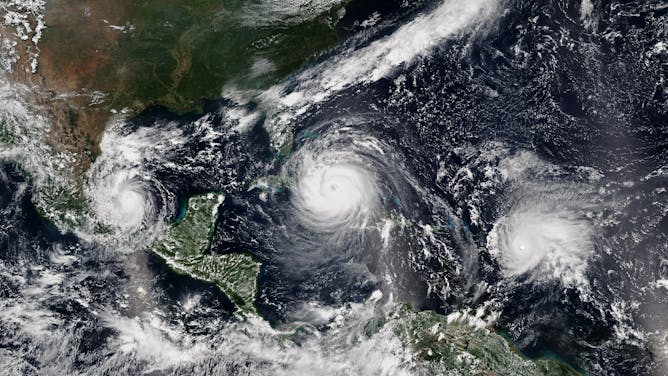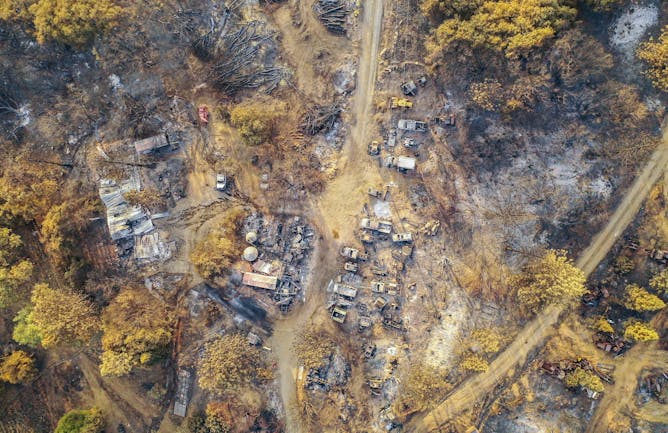|
|
|
|
As somebody who has covered climate change for years – and as a resident of the East Coast – I have long turned my attention to hurricanes around this time of year. NOAA will announce its official outlook for the season tomorrow, but hurricane forecaster Kristopher Karnauskas at University of Colorado Boulder gives us an inside look into how it’s done. He describes the complex interplay among many factors – the African monsoon, ocean temperatures, wind shear, El Niño and La Niña – that go into hurricane formation, all of which are both fascinating and useful as we officially begin the hurricane season June 1.
By now, most of us are probably aware that much of the Western U.S. is abnormally dry or in a drought, which of course can be a factor in another active wildfire year. But three climate scientists from Boise State, UC Irvine and UC Merced explain why the problems of another drought-stricken summer run far deeper. Ultimately, they say, the many knock-on effects of severe drought, combined with a growing population in the West, are challenging society’s ability to adapt.
In many ways, we’ve all been living through experiments imposed by the COVID-19 pandemic, whether it’s the physical and mental health toll of social distancing or the effect of online school on children. One research project, described in a story commissioned by science editor Maggie Villiger, explores the challenges pregnant mothers face during this time of isolation. In the years ahead, the researchers from USC Dornsife also intend to study how prenatal stress will influence the health of those born during the pandemic.
Here are some of this week’s other science stories:
If there’s a subject that you’d like our team of science editors to investigate, please reply to this email.
|
Martin La Monica
Director of Editorial Projects and Newsletters
|

|
|

Hurricanes Katia, Irma and Jose on Sept. 8, 2017.
NOAA
Kristopher Karnauskas, University of Colorado Boulder
To get a sense of how bad the 2021 hurricane season will be, keep an eye on the African monsoon, ocean temperatures and a possible late-blooming La Niña.
|

Dry conditions across the West follow a hot, dry year of record-setting wildfires in 2020. Communities were left with scenes like this, from California’s Creek Fire.
Amir Aghakouchak/University of California Irvine
Mojtaba Sadegh, Boise State University; Amir AghaKouchak, University of California, Irvine; John Abatzoglou, University of California, Merced
Drought conditions are so bad, fish hatcheries are trucking their salmon to the ocean and ranchers are worried about having enough water for their livestock.
|

Isolation and other pandemic stresses can harm pregnant women’s mental health, with effects on their babies too.
Jahi Chikwendiu/The Washington Post via Getty Images
Darby Saxbe, USC Dornsife College of Letters, Arts and Sciences; Alyssa Morris, USC Dornsife College of Letters, Arts and Sciences
Pregnant women's experiences can affect their babies' health, even into adulthood. Researchers know societywide stresses can lead to these long-term consequences – and the pandemic likely fits the bill.
|
Other good finds
|
-
Debbie-Ann Shirley, University of Virginia
The Pfizer COVID-19 vaccine was recently approved for adolescents ages 12-15. Vaccination is essential to protect children from serious illness and quicken return to normal life.
-
stef m. shuster, Michigan State University
Because little scientific evidence exists for trans medical treatments, doctors are often wary when working with trans people, even if they realize it's in the patients' best interests to do so.
-
Julie Brigham-Grette, University of Massachusetts Amherst; Andrea Dutton, University of Wisconsin-Madison
If emissions continue at their current pace, Antarctica will cross a threshold into runaway sea rise when today’s kids are raising families. Pulling CO2 out of the air later won't stop the ice loss.
-
Erin Baker, University of Massachusetts Amherst; Matthew Lackner, University of Massachusetts Amherst
The Biden administration has a goal of getting from today's 42 megawatts of offshore wind power to nearly 30,000 by the end of the decade, but there are still obstacles ahead.
-
Albert Folch, University of Washington
Electronics are not the only technology to have been miniaturized. Using the strange behavior of fluids in tiny spaces, microfluidic devices are critical to medicine, science and the modern world.
-
Lucca Henrion, University of Michigan; Joe Árvai, USC Dornsife College of Letters, Arts and Sciences; Lauren Lutzke, USC Dornsife College of Letters, Arts and Sciences; Volker Sick, University of Michigan
A large-scale survey asked people exactly that. One use of recycled carbon dioxide stood out.
Today’s graphic

|
|
| |
| |
| |
| |
| |
| |
|
|
|
|
|
|
|